The best Italian scout cruiser
The Quarto was the third Italian modern scout cruiser in service in 1915, when Italy went at war on the side of the entente. She was a light protected cruiser of the Regia Marina started in 1910 at Venice Admiralty NyD and often favourably compared to the Nino Bixio class. They traded speed for protection, but kept a reasonable armament, and she was a reliable gun platform, and a seaworthy vessel. Contrary to the disappointing Bixio and Marsala she was praised and used extensively during the Great war, having also a substantial career after the war, seeing WW2, but as a blockship. Her succession was represented by three “flotilla leaders” classes of 1916-1921, the Poerio, Mirabello and Leone classes, later reclassed as destroyers.
Naval Encyclopedia Podcast #1 (test – partial)
Italian scout cruisers
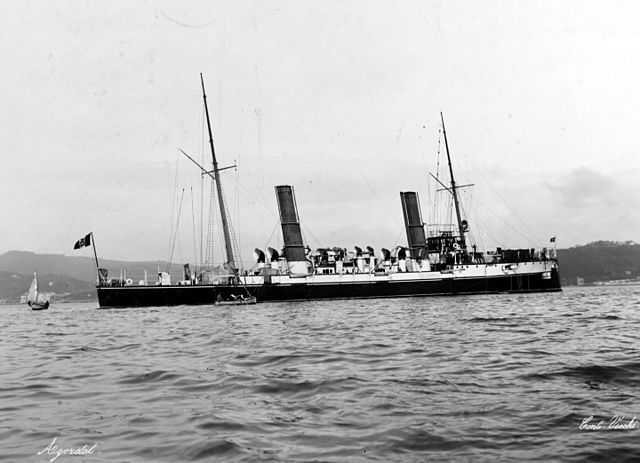
The Agordat and Coatit (22 knots) were just too slow as scouts in 1909
There has been a tradition of scouts in the Regia Marina, called “esploratori”, already in the 1860s. These were called “dispatch vessels” and were indeed very fast mixed paddle wheels vessels designed to carry orders from the admiral to other ships or battle line squadrons in operations. But in practice they were very much used as scouts. To the old Sesia rebuilt in 1862, succeeded the Esploratore class, the Vedetta (1866), Staffetta, Rapido (1876), Messaggero (1885), Barbarigo class (1879) and Archimedes class (1887). 1880-90s torpedo cruisers were too slow, but the last scouts were the Agordat class protected cruisers in 1899 designed by Nabor Soliani of Castellamare N Yd.
They were too slow to be effective as such. These 1300 tonnes, 300 feets vessels were the only modern “scouts” of the Navy when in 1907 it was decided to study a new class of such ships at a time the new Dreadnought type required a much faster vessel. This was even more obvious with the appearance of the battlecruisers in 1909. With their 23 knots on paper, rather 21-22 in practice and almost at forced heating, the Agordat and Coatit were indeed quite inappropriate.
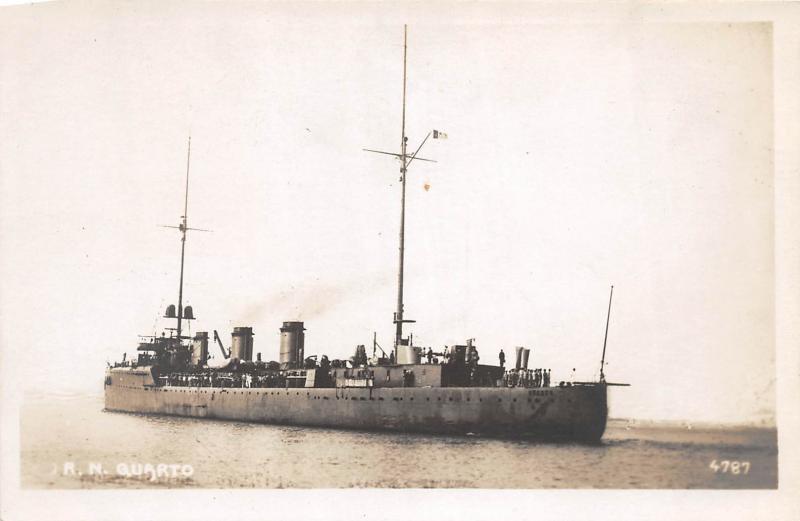
Italian cruiser Quarto – Postcard
Design of the Quarto
Hull construction and specifics
The Quarto was designed by Lieutenant Commander Giulio Truccone, as a scout cruiser, the first since the 1890s Agordat class. Truccone, from the Genio Navale established specifications and the general specifications, before the design was refined and blueprints generated at the Venice Admiralty naval yard design bureau. Time had passed since the Agordat and both the Dreadnought and new British scout cruisers confirmed the turbine was the only way forward to achieve greater speeds. Truccone took an active part in the interwar with the Comitato Progretti Navi, designing successful destroyers classes.
The basic drawing was relatively simple, with a slim hull, forecastle, three heavenly spaced funnels and artillery fore and aft, and in side sponsons. She was also fitted with a pair of pole masts and two conning towers, one at each end. The hull was was 126 meters (413 ft) long at the waterline, 131.6 m (432 ft) overall with a 12.8 m (42 ft) beam and a 4.1 m (13 ft) draft. Displacement i service was 3,271 long tons (3,323 t) standard, up to 3,442 long tons (3,497 t) fully loaded and battle ready. She carried 13 officers and 234 sailors.
Propulsion
Due its intended role, the cursor was definitively placed on speed. The only way to achieve it was to use steam turbines instead of the classic VTEs (Vertical Tubes Steam, or piston Engines) which proved not able to deliver. So Quarto became the very first Italian cruiser to be fitter with turbines, a landmark in the Regia Marina history.
The powerplant consisted in four Parsons steam turbines driving a bronze propeller of 2.1 m diameter each. Steam came from eight oil-fired boilers and two mixed coal/oil-fired Blechynden boilers. The latter were discarded on the ling run. They were trunked into three funnels and total output as registered by the yard was 25,000 horsepower (19,000 kW) for a designed top speed of 28 knots (52 km/h; 32 mph). Trials saw her exceeding these figures with 29,215 ihp (21,786 kW) produced for 28.61 kn (52.99 km/h; 32.92 mph).
Quarto was about to achieve 2,300 nautical miles (4,300 km; 2,600 mi) at 15 knots (28 km/h; 17 mph), reduced to 588 nautical miles or 1,089 km (677 land miles) at top speed. This allowed her to reach her Mediterranean destination and then race to the supposed position of the enemy, spot it and run back to safety.
Protection:
As expected, Quarto’s protection was sacrificed to achieve greater speeds, consisting of a 38 mm (1.5 in) thick armoured deck above the waterline, and wall 100 mm (3.9 in) around her main conning tower.
Armament
Quarto’s armament was reasonably good, with six 120 mm (4.7 in) L/50 guns single mounts. The forecastle had two side by side, two more on the main deck further aft, two on the upper deck, behind the rear conning tower. In addition they were slightly offset, the port gun being further aft to allow greater margin when firing, not having the blast endangering the crews.
These guns were of the Pattern EE type (used also on the Dante Alighieri and Conte di Cavour, coming from by Armstrong Whitworth. They were completed by six 76 mm (3 in) L/50 guns, Pattern ZZI for close range defence. To complete this, the Quarto also carried two 450 mm (17.7 in) torpedo tubes placed in deck banks, but after commission they were replaced by submerged tubes. She was also given rails to carry some 200 naval mines, although this was never done in service.
The Quarto in action
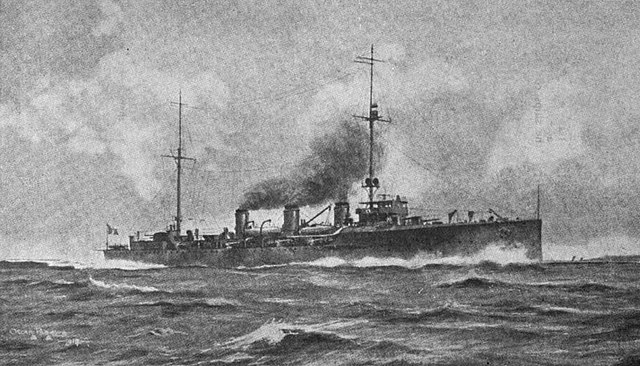
Quarto was was laid down on 14 November 1909, was launched on 19 August 1911 in Venice (two years, which was relatively long) and fitted-out by early 1913 to be commissioned on 31 March 1913. Her early service was at first limited both to the Adriatic and Ionian Seas. She has been badly damaged by a fire was was long held in repairs, emerging by May 3, 1914 . Italy was neutral in August 1914, but no longer by July 1915, convinced by the Triple Entente. The Regia Marina was soon pitted against the Austro-Hungarian Navy.
However the Navy chief of staff Admiral Paolo Thaon di Revel feared the presence of Austro-Hungarian submarines in the narrow waters of the Adriatic and preferred to bar their way with minefields. Very soon, the Tarento barrage, a mixed mines and patrol ships blockading line at the southern end of the Adriatic, was set in place, with MAS boats ready to take action at a moment notice. This did not prevent raids to be mounted on Austro-Hungarian assets along the coast.
Quarto and the two Nino Bixio-class cruisers was based at Brindisi, near the barrage, and the most likely to intervene in case of an Austro-Hungarian sortie. Quarto made numerous sorties, and apparently met enemy submarines several times, which all torpedoed but failed to hit her, misjudged her speed as a result of her very shallow draft and misleading wave pattern. She became therefore the only Italian cruiser to effectively roam the Adriatic in relative impunity. In total she held 54 combat missions, plus 9 escort missions, totalling 1336 hours of navigation.
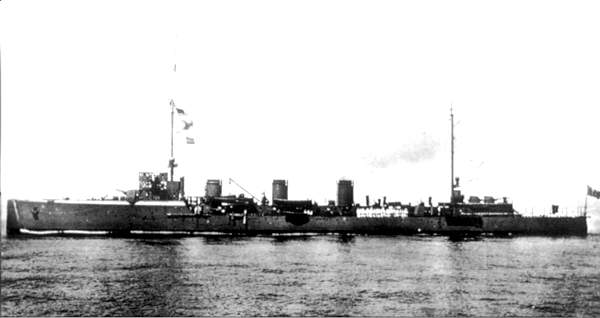
Esploratore Quarto in 1925
By December 1915, two Austro-Hungarian scout cruisers and five destroyers fell onto transports supplying the Serbian Army trapped in Albania. Quarto (Rear Admiral Silvio Bellini), assisted by the British cruiser HMS Dartmouth and five French destroyers, rushed from Brindisi. A second wave comprising Nino Bixio, HMS Weymouth and four Italian destroyers followed closely. Quarto and Dartmouth spotted and engaged SMS Helgoland, making a long-range gunnery duel. Helgoland however was faster and escaped after the fall of darkness. In May 1917, Rear Admiral Alfredo Acton took the head of the squadron, raising his mark on the Quarto. However the latter missed the Battle of the Otranto Straits having no time to steam up when the force learned of the Austro-Hungarian raid. The war ended, and contrary to the mediocre Nino Bixio class, Quarto was kept in service.
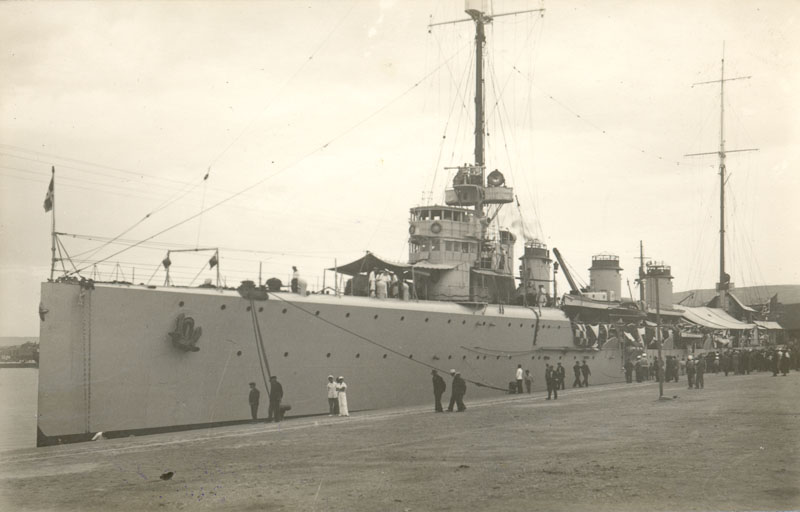
The Quarto in Varna circa 1925
In 1926–1927 she was modernized, with all oil-firing boilers and carrying a Macchi M.18 seaplane. Quarto was sent to East Asian waters in the early 1930s, replaced the cruiser Libia on station. She became the flagship of the 2nd Division Torpedo Bomber, and made numerous missions between the red sea and China.
She was transferred back to Africa, supporting the Second Italo-Ethiopian War of 1935–1936. Her old 3-in (76 mm) guns were replaced by 13.2 mm (0.52 in) Breda heavy machine guns by that time. She became the flagship of Rear Admiral Alberto di Moriondo and operated off Spain as part of the non-intervention patrols during the Spanish Civil War. On 24 May 1937 she was attacked by Spanish Republican bombers, and took near-hits as she was moored in Palma, Majorca.
By August 1938 one of her old boilers exploded. But she was repaired and remained in service before WW2 erupted, stricken on 5 January 1939. She was towed from La Spezia to Livorno, and her hull was demilitarize, and used for experiments, notably as target for the new SLC human torpedo. This was precious for setting up the Decima Flottiglia MAS, in early 1940. Three SLCs indeed successfully planted dummy explosives under her hull. By November 1940, she was targeted by MT explosive motorboats equipped with reduced charges which nevertheless caused significant damage to Quarto hull, to the point she quickly sank. However she was towed and her wreckage was used to block the entrance to the port of Livorno in July 1944.
Links/Src
//forum.worldofwarships.eu/topic/2153-the-explorer-quarto/
Mussolini’s Navy a reference guide 1930-45
Specs Conway’s all the world fighting ships 1906-1921.
//en.wikipedia.org/wiki/Agordat-class_cruiser
//en.wikipedia.org/wiki/Italian_cruiser_Quarto
//www.worldnavalships.com/italian_cruisers.htm
//web.archive.org/web/20110104185951/http://www.marinai.it/contatti/quarto.pdf
//www.navypedia.org/ships/italy/it_cr_quarto.htm
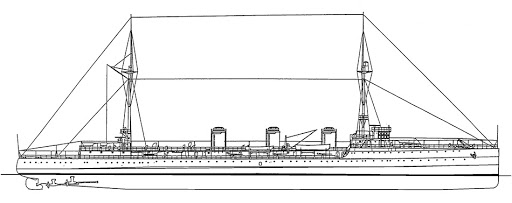
Blueprint of the Quarto
Quarto specifications |
|
| Dimensions | 131,6 m x 12,8 m x 4,1 m (432 x 42 x 13 fts) |
| Displacement | 3,281 t standard, 3,441 tonnes FL |
| Crew | 12 + 311 |
| Propulsion | 2 shaft Parsons turbines, 10 boilers, total 25 000 hp |
| Speed | 28 knots (52 km/h; 32 mph) |
| Range | 2,300 nmi (4,300 km; 2,600 mi) @ 15 knots (28 km/h; 17 mph) |
| Armament | 6× 120 mm (4.7 in), 6× 76 mm (3 in), 2x 47 mm, 2× 450 mm (17.7 in) TTs, 200 mines . |
| Armor | Deck: 38 mm (1.5 in), Conning tower: 100 mm (3.9 in) |

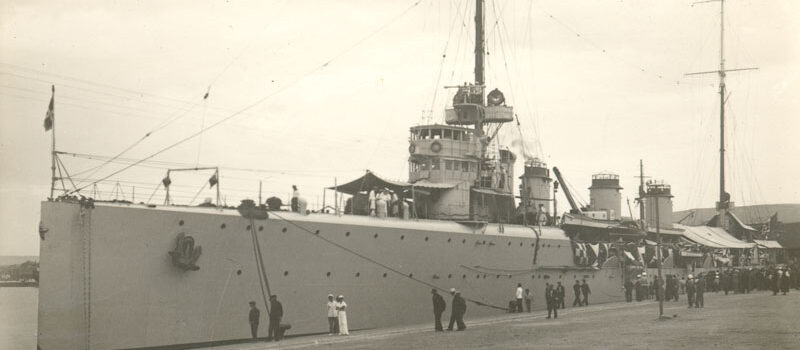

 Latest Facebook Entry -
Latest Facebook Entry -  X(Tweeter) Naval Encyclopedia's deck archive
X(Tweeter) Naval Encyclopedia's deck archive Instagram (@navalencyc)
Instagram (@navalencyc)





 French Navy
French Navy Royal Navy
Royal Navy Russian Navy
Russian Navy Armada Espanola
Armada Espanola Austrian Navy
Austrian Navy K.u.K. Kriegsmarine
K.u.K. Kriegsmarine Dansk Marine
Dansk Marine Nautiko Hellenon
Nautiko Hellenon Koninklije Marine 1870
Koninklije Marine 1870 Marinha do Brasil
Marinha do Brasil Osmanlı Donanması
Osmanlı Donanması Marina Do Peru
Marina Do Peru Marinha do Portugal
Marinha do Portugal Regia Marina 1870
Regia Marina 1870 Nihhon Kaigun 1870
Nihhon Kaigun 1870 Preußische Marine 1870
Preußische Marine 1870 Russkiy Flot 1870
Russkiy Flot 1870 Svenska marinen
Svenska marinen Søværnet
Søværnet Union Navy
Union Navy Confederate Navy
Confederate Navy Armada de Argentina
Armada de Argentina Imperial Chinese Navy
Imperial Chinese Navy Marinha do Portugal
Marinha do Portugal Mexico
Mexico Kaiserliche Marine
Kaiserliche Marine 1898 US Navy
1898 US Navy Sovietskiy Flot
Sovietskiy Flot Royal Canadian Navy
Royal Canadian Navy Royal Australian Navy
Royal Australian Navy RNZN Fleet
RNZN Fleet Chinese Navy 1937
Chinese Navy 1937 Kriegsmarine
Kriegsmarine Chilean Navy
Chilean Navy Danish Navy
Danish Navy Finnish Navy
Finnish Navy Hellenic Navy
Hellenic Navy Polish Navy
Polish Navy Romanian Navy
Romanian Navy Turkish Navy
Turkish Navy Royal Yugoslav Navy
Royal Yugoslav Navy Royal Thai Navy
Royal Thai Navy Minor Navies
Minor Navies Albania
Albania Austria
Austria Belgium
Belgium Columbia
Columbia Costa Rica
Costa Rica Cuba
Cuba Czechoslovakia
Czechoslovakia Dominican Republic
Dominican Republic Haiti
Haiti Hungary
Hungary Honduras
Honduras Estonia
Estonia Iceland
Iceland Eire
Eire Equador
Equador Iran
Iran Iraq
Iraq Latvia
Latvia Liberia
Liberia Lithuania
Lithuania Mandchukuo
Mandchukuo Morocco
Morocco Nicaragua
Nicaragua Persia
Persia San Salvador
San Salvador Sarawak
Sarawak Uruguay
Uruguay Venezuela
Venezuela Zanzibar
Zanzibar Warsaw Pact Navies
Warsaw Pact Navies Bulgaria
Bulgaria Hungary
Hungary

 Bundesmarine
Bundesmarine Dutch Navy
Dutch Navy Hellenic Navy
Hellenic Navy Marina Militare
Marina Militare Yugoslav Navy
Yugoslav Navy Chinese Navy
Chinese Navy Indian Navy
Indian Navy Indonesian Navy
Indonesian Navy JMSDF
JMSDF North Korean Navy
North Korean Navy Pakistani Navy
Pakistani Navy Philippines Navy
Philippines Navy ROKN
ROKN Rep. of Singapore Navy
Rep. of Singapore Navy Taiwanese Navy
Taiwanese Navy IDF Navy
IDF Navy Saudi Navy
Saudi Navy Royal New Zealand Navy
Royal New Zealand Navy Egyptian Navy
Egyptian Navy South African Navy
South African Navy






























 Ukrainian Navy
Ukrainian Navy dbodesign
dbodesign